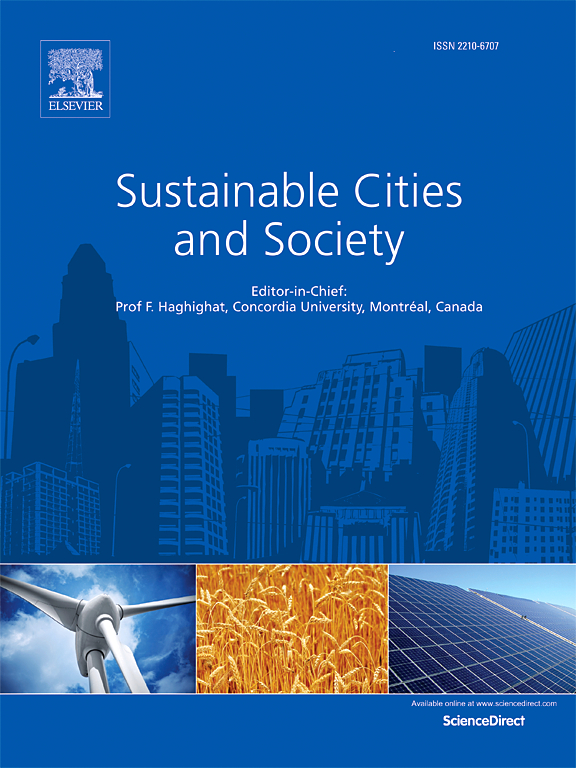基于城市规模的紧凑型城市碳减排影响:基于卫星影像的空间分析
IF 10.5
1区 工程技术
Q1 CONSTRUCTION & BUILDING TECHNOLOGY
引用次数: 0
摘要
城市对全球碳排放贡献巨大,通过有效的空间规划实现可持续发展对实现碳中和至关重要。由于分散发展对社会和环境的影响,紧凑的城市对城市规划至关重要。然而,研究人员持不同意见,争论仍在继续。随着城市的扩张,它们会产生不同的影响,强调需要考虑区域特征,而不是依赖单一的评估框架。了解城市规模和空间结构之间的相互作用至关重要,因为紧凑的城市要素与碳排放之间的关系是复杂的。本研究旨在通过考虑紧凑城市的城市规模,并分析美国和韩国的城市,来阐明紧凑城市的碳减排效果。例如,虽然大城市的紧凑性可能会减少排放,但小城市可能会产生相反的效果。利用卫星图像,本研究不仅测量了碳排放和三个紧凑型城市特征,还进行了面板阈值回归分析,以评估这些因素如何影响不同城市规模的排放。结果表明:紧凑型城市特征对碳排放的影响随城市规模的变化而变化,城市规模与空间结构之间存在显著的交互作用。例如,分析证实,尽管有环境法规和技术进步,但降低人均VKT是必不可少的。在小城市,紧凑程度越高往往会增加碳排放,但超过一定规模,紧凑程度越高则有助于减少碳排放。同样,虽然多中心性增加了小城市的排放量,但随着城市的发展,它有助于降低排放量。这强调了了解与城市规模和结构有关的排放趋势的重要性,同时提倡有针对性的空间规划和战略办法,而不是统一的政策。本文章由计算机程序翻译,如有差异,请以英文原文为准。
Impact of Compact City on Carbon Emission Reduction Based on Urban Size: A Spatial Analysis Using Satellite Imagery
Cities contribute significantly to global carbon emissions, making sustainable development through efficient spatial planning essential for achieving carbon neutrality. Compact cities are crucial for urban planning because of concerns regarding the impact of dispersed development on society and the environment. However, researchers hold differing opinions, and debates continue. As cities expand, they develop different influences, underscoring the need to consider regional characteristics rather than rely on a single assessment framework. Understanding the interaction between urban size and spatial structure is vital because the relationship between compact city elements and carbon emissions is complex. This study aimed to clarify the carbon emission reduction effects of compact cities by considering their urban size and analyzing cities in the United States and South Korea. For example, although the compactness in larger cities may reduce emissions, the opposite effect may occur in smaller cities. Using satellite imagery, this study not only measured carbon emissions and three compact city characteristics but also conducted a panel threshold regression analysis to assess how these elements influenced emissions across various urban sizes. The results indicated that the impact of compact city characteristics on emissions varied with urban size, highlighting the significant interaction between urban size and spatial structure. For example, the analysis confirmed that reducing per capita VKT is essential despite environmental regulations and technological advancements. In small cities, greater compactness tends to increase carbon emissions, but beyond a certain size it contributes to their reduction. Likewise, while polycentricity increase emissions in smaller cities, it helps lower them as the city grows. This underscores the importance of understanding emission trends in relation to urban size and structure, while advocating for tailored spatial planning and strategic approaches rather than uniform policies.
求助全文
通过发布文献求助,成功后即可免费获取论文全文。
去求助
来源期刊

Sustainable Cities and Society
Social Sciences-Geography, Planning and Development
CiteScore
22.00
自引率
13.70%
发文量
810
审稿时长
27 days
期刊介绍:
Sustainable Cities and Society (SCS) is an international journal that focuses on fundamental and applied research to promote environmentally sustainable and socially resilient cities. The journal welcomes cross-cutting, multi-disciplinary research in various areas, including:
1. Smart cities and resilient environments;
2. Alternative/clean energy sources, energy distribution, distributed energy generation, and energy demand reduction/management;
3. Monitoring and improving air quality in built environment and cities (e.g., healthy built environment and air quality management);
4. Energy efficient, low/zero carbon, and green buildings/communities;
5. Climate change mitigation and adaptation in urban environments;
6. Green infrastructure and BMPs;
7. Environmental Footprint accounting and management;
8. Urban agriculture and forestry;
9. ICT, smart grid and intelligent infrastructure;
10. Urban design/planning, regulations, legislation, certification, economics, and policy;
11. Social aspects, impacts and resiliency of cities;
12. Behavior monitoring, analysis and change within urban communities;
13. Health monitoring and improvement;
14. Nexus issues related to sustainable cities and societies;
15. Smart city governance;
16. Decision Support Systems for trade-off and uncertainty analysis for improved management of cities and society;
17. Big data, machine learning, and artificial intelligence applications and case studies;
18. Critical infrastructure protection, including security, privacy, forensics, and reliability issues of cyber-physical systems.
19. Water footprint reduction and urban water distribution, harvesting, treatment, reuse and management;
20. Waste reduction and recycling;
21. Wastewater collection, treatment and recycling;
22. Smart, clean and healthy transportation systems and infrastructure;
 求助内容:
求助内容: 应助结果提醒方式:
应助结果提醒方式:


